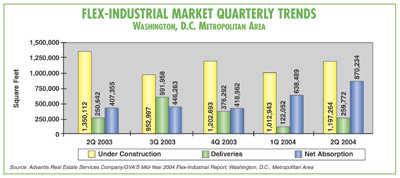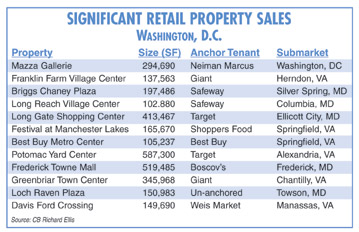|
CITY HIGHLIGHT, OCTOBER 2004
REAL ESTATE OUTLOOK POSITIVE ON CAPITOL
HILL
The Washington, D.C., commercial real estate market is healthy
in all sectors. New projects are being developed and, with
job creation on the rise, the outlook for the city and surrounding
areas is positive.
Industrial
The industrial real estate market in the Washington, D.C./suburban
Maryland and Baltimore region is seeing a renaissance of new
development with seven new projects under construction and/or
planned for 2005 and 2006 delivery. Previous years saw an
exodus of Class A industrial tenants from this region for
“greener pastures,” which offered large footprint
industrial buildings with lower rental rates. These new industrial
projects should finally bring Class A industrial tenants back
to the area.
There are several reasons for this spike in new development.
First, the “greener pastures” are much less available.
Land availability along Interstate 95 from Washington up through
Philadelphia is extremely limited and prices are now reaching
the same level as available land in the Washington area. Industrial
land prices range from $150,000 to $250,000 per acre or $13
to $17 per buildable square foot. Second, there is a growing
appetite for investment in industrial product in this area.
This capital has provided both the funding for new development
and an exit strategy (disposition) for speculative developers.
Partially fueling the investment appetite is the area’s
healthy market dynamics with a 9.4 percent vacancy rate. Net
absorption is steady and rental rates are climbing, with average
effective rental rates for Class A buildings at $5.95 per
square foot net and $4.85 per square foot net for Class B
buildings. Fully leased Class A and Class B buildings are
selling for sub-8 cap rates, and $80 per-square-foot prices.
The area’s retail sector and the federal government continue
to drive the market. Defense contractors have acquired industrial
space both for storage and redevelopment into inexpensive
office space. As the economy continues to improve, we are
seeing more and more corporate users expanding their operations.
The Home Depot, for example, continues to search for 400,000
square feet near Washington with literally no options that
size in existing buildings or build-to-suits.
— James Lighthizer, senior vice president, CB Richard
Ellis

Retail
Current retail property capital market conditions are the
strongest they have been in the Washington-Baltimore metropolitan
area and in the U.S. in the past 20 years. The demand for
shopping center investments is extremely strong across all
retail property types and classes. Grocery-anchored neighborhood
and community centers, regional power centers, regional malls,
unanchored strip centers and mixed-use projects with retail
components are attracting strong investor interest and are
subject to a competitive bidding environment. This demand
is strong for both core and value-add retail opportunities.
Both are trading at a premium to their historic pricing levels.
Nationally, demand for retail investment properties is being
driven by low interest rates, the availability of debt and
equity capital, the lack of attractive alternative investments,
and the fact that retail properties as an asset class have
historically delivered one of the most stable and reliable
returns of all the real estate property types.
In the D.C. metropolitan area, demand for retail investment
properties is particularly strong for several reasons:
• Extremely low retail vacancy rates. Infill areas of
Fairfax and Montgomery counties have retail vacancy rates
of less than 2 percent.
• Zoning and land use controls that restrict future retail
development and prevent overbuilding.
• Strong regional economy that consistently outperforms
the US average.
• A long, consistent history of retail rental rate growth.
Capitalization rates for well-located, well-anchored, stabilized
shopping centers range from 6 to 8 percent. Pricing for the
very best neighborhood centers is now more than $275 per square
foot. The capitalization rate trade range is a much broader
and less meaningful benchmark for value-add retail properties.
This range has been as broad as 7 to 12 percent depending
on a number of factors, including occupancy, physical condition,
remaining lease terms, tenant credit, trade area competition,
and total cost for redevelopment plan execution and center
stabilization. As-is cap rate, stabilized cap rate, replacement
cost, interest carry cost during redevelopment and risk adjusted
development return hurdle rates are all factors that investors
evaluate in pricing value-add shopping center opportunities.
The combination of strong pricing and demand are resulting
in higher than normal shopping center sales volume. The active
investors include pension funds, real estate investment trusts,
high net worth individuals, offshore investors and opportunity
funds.
The pipeline of retail properties on the market, under contract
and coming to market in the third quarter continues at a high
level. The strong demand and increased investment sale activity
for shopping centers in the Washington-Baltimore metropolitan
area is expected to continue through the remainder of 2004.
— William Kent, executive vice president, investment
properties – institutional group, CB Richard Ellis

Office
The Washington, D.C., office market reached mid-year 2004
with strong leasing, investment and retail activity. With
108 million square feet of existing competitive inventory
and another 6 million square feet under construction, the
city has maintained an enviable vacancy level in the mid-single
digits. Market analysts are keeping a close watch on the northeastern
portion of the East End market, a notable, emerging micro-market.
A third of all new construction is concentrated within a few
blocks of the newly opened Convention Center. Currently at
9 percent vacant, speculative construction could force the
East End’s vacancy rate above 10 percent for the first
time since 1997. Once considered a fringe location, quality
sponsorship and first-class construction have attracted law
firms. The turning point for this micro-market came with Boston
Properties’ construction of 901 New York Ave. Additional
development by Louis Dreyfus Property Group at 1101 New York
Ave. and by JBG Companies at 1101 K St. will benefit from
being anchored on the east by 901 New York’s success.
Net absorption surpassed the 2003 total of 900,000 square
feet and reached 1.5 million square feet by July. As in 2003,
lease renewals remain the biggest competition to new construction
and five of the largest deals completed thus far this year
were renewals. At the same time, large law firms that inked
their last deals in the late 1980s and early 1990s and are
now facing expansion constraints are fueling the demand after
6 years of single-digit vacancy rates and 13.4 million square
feet of net growth downtown. These law firms, wishing to deliver
from both a national and international platform, are finding
a presence in the nation’s capital imperative. Short
of a major terrorism event, Washington will maintain its stable
occupancy.
Class A asking rents continue to climb, rising from $43 to
$44 per square foot in the first 6 months of 2004 — yet
fierce competition has enabled savvy tenants to secure large
concession packages from some landlords that have included
free rent — not seen with any frequency since the early
1990s — and assumptions of lease liability.
The vibrant investment market is continuing the blistering
pace set in 2003. More than $1.3 billion worth of property
has changed hands during the first half of 2004 with five
transactions in excess of $100 million. At present there are
relatively few properties formally being offered for sale
downtown, fueling an increase in speculative off-market activity.
Only the staunchest of long-term investors are turning a deaf
ear to the sound of investors clamoring for product. Several
properties that changed hands only a year ago are back on
the market and poised to provide their short-term owners significant
profits.
— Jay Olshonsky, managing director, CB Richard Ellis’
Washington, D.C., office
Multifamily
With the overall health of the market still being at very
desirable levels, the pipeline of new product in Washington,
D.C.’s multifamily market is substantial. Luckily, demand
for rental housing is keeping with this supply mainly due
to two reasons: jobs and conversions. The D.C. metropolitan
region is still leading the nation in new job creation, a
trend that is not temporary as it has lasted for several years
and is expected to continue, according to Stephen Fuller of
George Mason University.
Furthermore, as an alternative to rising single-family home
prices, the condo conversion craze continues to strengthen
the health of the market by depleting the inventory of new
units. Additionally, many former apartment sites are being
converted to condominiums before construction begins, thus
further lessening the number of units coming on line. One
apartment developer has been quoted to say, “I have been
as successful selling my property at the entitlement stage
as I have after stabilization.”
There have been several major mixed-use projects that have
either taken steps to become a reality or achieved recent
recognition. The formation of the Anacostia Waterfront Development
Corporation shows D.C.’s desire to move ahead on the
redevelopment of the Southwest Waterfront area after years
of being on the drawing board. In Virginia, a vibrant downtown
area will be created with the massive Potomac Yards mixed-use
development. The first stage of the project will include a
479-unit condo project developed by Comstock and 386-unit
luxury high-rise developed by Camden as well as a Harris Teeter
and more than 600,000 square feet of office space. The area’s
most recent development of significance is putting Prince
Georges County, Maryland, on the national map for mixed-use
developments with the announcement of the $3 billion project
called Rosewood. Just 120 miles east of Washington, the project
will be situated on 480 acres and is reported to eventually
contain 6,000 residential units.
Two different trends are taking place around the Metro region.
The first is based on demand for housing and the second is
based on supply of land. As noted by the recent, huge surge
in housing growth in more infill or urban population centers,
potential residents are drawn toward the live/work/play areas
with easy access to retail and public transportation. Areas
that demonstrate this trend in Maryland are Bethesda, Rockville
and Silver Spring; Alexandria and Arlington in Virginia; and
lastly the District itself. The demand is high for predominantly
high-rise living where residents can walk to restaurants,
shopping and the Metro.
The second trend is evidenced by the availability of land
for development in submarkets with pent-up demand located
in an environment that is receptive to development. In Virginia,
this has been demonstrated near the Fairfax Towne Center and
throughout Eastern Loudoun County, while in Maryland, this
is evidenced by several developments in Anne Arundel County.
— Drew White, Cushman & Wakefield’s capital
markets group, apartment brokerage services, Washington, D.C.
©2004 France Publications, Inc. Duplication
or reproduction of this article not permitted without authorization
from France Publications, Inc. For information on reprints
of this article contact Barbara
Sherer at (630) 554-6054.
|
